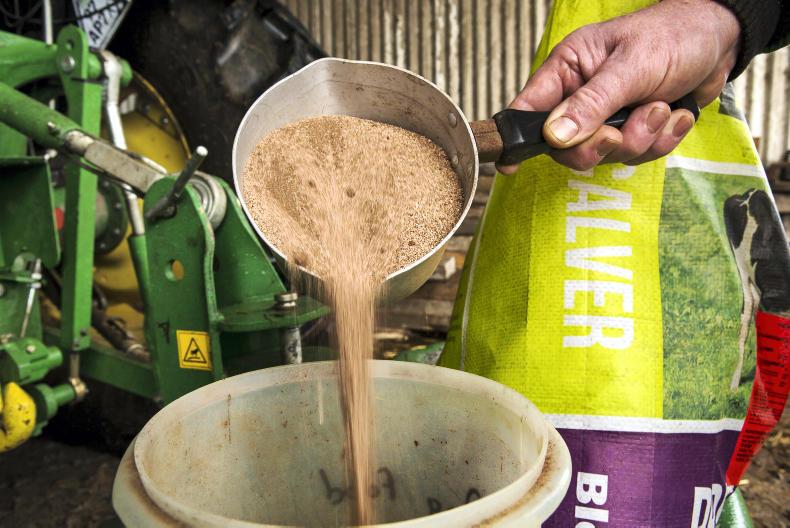If you haven’t already done so, you need to buy dry cow minerals. Cows will need a minimum of six weeks of supplementary mineral feeding before calving.
With most spring-calving herds starting to calve down at the end of January or early February, it means that dry cow feeding should commence very shortly.
There are lots of products on the market and it gets confusing comparing all the different types. By right, the type of dry cow mineral required depends on the mineral analysis of the silage.
Key ingredients
In the absence of this, most farmers will just buy an off-the-shelf mineral. The key ingredients are magnesium and phosphorus.
Low inclusion rates of each will lead to cheaper minerals to buy, but you will have to feed more of them, so really it’s a false economy.
Standard feeding rates are 120g per cow per day, so compare different specs to this common feeding rate.
If silage is high in potash, then this silage should not be fed to cows close to calving
The dry cow requires between 20g and 25g of magnesium per day before calving. If the label says there is 20% magnesium in the mineral mix and you are feeding 120g per day, then the cows are getting 24g of magnesium per day.
The next big one is phosphorus. Not all minerals will have phosphorus included, but most cows need around 4g/day before calving. Minerals with high phosphorus levels are generally more expensive.
Trace elements
Trace elements, such as copper, selenium and zinc, are also important. For selenium, the target is for 5mg or 6mg per day pre-calving. If it says there is 50mg on the label and if 120g per day is fed, then the cows will be consuming 6mg per day.
Iodine is a tricky one. By right, it should not be fed at more than 12mg per cow per day, but if the forage is very low in iodine, then more will have to be supplemented in the minerals.
Iodine deficiencies are common in some farms and result in slow calvings and weak calves.
Vitamin D is also important and should be included at a rate of at least 120,000 units per kilo of mineral. This is important in the prevention of milk fever.
Also important in the prevention of milk fever is low potash levels in silage. If silage is high in potash, then this silage should not be fed to cows close to calving. Ideally, silage should be less than 2% in potassium.
Read more
Spotlight on nitrogen for dairy farmers
Dairy management: should you dose dry cows for fluke?
If you haven’t already done so, you need to buy dry cow minerals. Cows will need a minimum of six weeks of supplementary mineral feeding before calving.
With most spring-calving herds starting to calve down at the end of January or early February, it means that dry cow feeding should commence very shortly.
There are lots of products on the market and it gets confusing comparing all the different types. By right, the type of dry cow mineral required depends on the mineral analysis of the silage.
Key ingredients
In the absence of this, most farmers will just buy an off-the-shelf mineral. The key ingredients are magnesium and phosphorus.
Low inclusion rates of each will lead to cheaper minerals to buy, but you will have to feed more of them, so really it’s a false economy.
Standard feeding rates are 120g per cow per day, so compare different specs to this common feeding rate.
If silage is high in potash, then this silage should not be fed to cows close to calving
The dry cow requires between 20g and 25g of magnesium per day before calving. If the label says there is 20% magnesium in the mineral mix and you are feeding 120g per day, then the cows are getting 24g of magnesium per day.
The next big one is phosphorus. Not all minerals will have phosphorus included, but most cows need around 4g/day before calving. Minerals with high phosphorus levels are generally more expensive.
Trace elements
Trace elements, such as copper, selenium and zinc, are also important. For selenium, the target is for 5mg or 6mg per day pre-calving. If it says there is 50mg on the label and if 120g per day is fed, then the cows will be consuming 6mg per day.
Iodine is a tricky one. By right, it should not be fed at more than 12mg per cow per day, but if the forage is very low in iodine, then more will have to be supplemented in the minerals.
Iodine deficiencies are common in some farms and result in slow calvings and weak calves.
Vitamin D is also important and should be included at a rate of at least 120,000 units per kilo of mineral. This is important in the prevention of milk fever.
Also important in the prevention of milk fever is low potash levels in silage. If silage is high in potash, then this silage should not be fed to cows close to calving. Ideally, silage should be less than 2% in potassium.
Read more
Spotlight on nitrogen for dairy farmers
Dairy management: should you dose dry cows for fluke?






 This is a subscriber-only article
This is a subscriber-only article









SHARING OPTIONS: